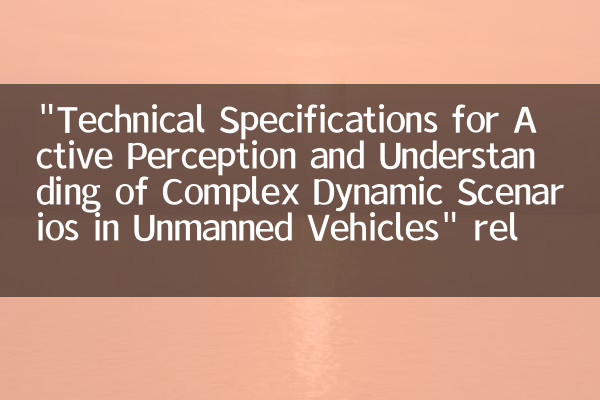"Technical Specifications for Active Perception and Understanding of Complex Dynamic Scenarios in Unmanned Vehicles" released
Recently, the National Standardization Management Committee and the Ministry of Industry and Information Technology officially released the "Technical Specifications for Active Perception and Understanding of Complex Dynamic Scenarios in Unmanned Vehicles", marking an important step in my country's standardization construction in the field of unmanned driving technology. This technical specification aims to solve the perception and decision-making problems of unmanned vehicles in complex dynamic environments, and provides the industry with a unified technical reference.
1. Core content of technical specifications

This specification puts specific requirements for unmanned vehicle technology from three dimensions: perception, understanding, and decision-making. The following are structured data of the key content:
| Technical modules | Core Requirements | Performance metrics |
|---|---|---|
| Environmental perception | Multi-sensor fusion accuracy | ≥95% target recognition accuracy |
| Dynamic prediction | Pedestrian trajectory prediction ability | Prediction error within 3 seconds ≤0.5 meters |
| Decision Response | Emergency braking reaction time | ≤100 milliseconds |
| System redundancy | Switching time of main and standby system | ≤50 milliseconds |
2. Industry hotspot background
Data on topics related to autonomous driving that have been hotly discussed across the Internet in the past 10 days show that technical safety and policy breakthroughs have become the focus:
| Hot Topics | Discussion volume (10,000) | Main focus |
|---|---|---|
| Level 4 autonomous driving test | 128.5 | Beijing, Shanghai, Guangzhou and Shenzhen Open Test Area |
| V2X vehicle-road collaboration | 92.3 | 5G+Beidou technology integration |
| Ethical Algorithm Dispute | 156.7 | Emergency decision-making logic |
| Lidar price cut | 84.2 | The domestic production rate exceeded 70% |
3. Highlights of technological breakthroughs
The new specification emphasizes"Active perception"Technical system, including:
1.Heterogeneous sensor space-time alignment: Requires data synchronization errors of millimeter-wave radar, lidar and vision sensors to be controlled within 10 nanoseconds
2.Intent to understand the model: Establish a driving behavior knowledge graph containing 200+ typical scenarios to realize the intention prediction of pedestrians and vehicles
3.Edge computing architecture: It is stipulated that local computing units must have computing power of 16TOPS or above to ensure real-time processing capabilities
According to experts involved in the formulation of standards, these technical requirements have reached the international leading level, and some indicators are 20%-30% higher than the current standards in Europe and the United States.
IV. Analysis of industrial impact
After the standards are issued, leading companies will respond immediately:
| enterprise | Response measures | schedule |
|---|---|---|
| Company A | Upgrade perception algorithm | Q4 completes adaptation |
| Group B | New testing ground | Started production in 2024 |
| C Technology | Release Compliant Chips | Mass production |
Industry experts predict that after the implementation of this specification, my country's unmanned road test pass rate is expected to increase from the current 68% to more than 85%, which will accelerate the commercialization process. It is estimated that by 2025, the production of unmanned vehicles that comply with the new regulations will exceed 500,000, driving the scale of upstream and downstream industrial chains to exceed 200 billion yuan.
5. Future Outlook
With the implementation of technical specifications, we will focus on the next stepThree major directions: Construction of urban-level digital twin testing platform, formulation of cross-brand vehicle collaborative communication protocols, and performance verification standards under extreme weather conditions. These measures will further consolidate my country's international competitive advantages in the field of intelligent connected vehicles.

check the details

check the details